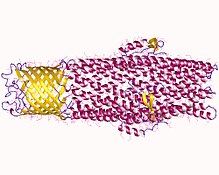

An efflux pump is an active transporter in cells that moves out unwanted material. Efflux pumps are an important component in bacteria in their ability to remove antibiotics.[1] The efflux could also be the movement of heavy metals, organic pollutants, plant-produced compounds, quorum sensing signals, bacterial metabolites and neurotransmitters. All microorganisms, with a few exceptions, have highly conserved DNA sequences in their genome that encode efflux pumps. Efflux pumps actively move substances out of a microorganism, in a process known as active efflux, which is a vital part of xenobiotic metabolism. This active efflux mechanism is responsible for various types of resistance to bacterial pathogens within bacterial species - the most concerning being antibiotic resistance because microorganisms can have adapted efflux pumps to divert toxins out of the cytoplasm and into extracellular media.[2]
Efflux systems function via an energy-dependent mechanism (active transport) to pump out unwanted toxic substances through specific efflux pumps. Some efflux systems are drug-specific, whereas others may accommodate multiple drugs with small multidrug resistance (SMR) transporters.[3][4]
Efflux pumps are proteinaceous transporters localized in the cytoplasmic membrane of all kinds of cells. They are active transporters, meaning that they require a source of chemical energy to perform their function. Some are primary active transporters utilizing adenosine triphosphate hydrolysis as a source of energy, whereas others are secondary active transporters (uniporters, symporters, or antiporters) in which transport is coupled to an electrochemical potential difference created by pumping hydrogen or sodium ions into the cell.
- ^ Sharma A, Gupta VK, Pathania R (February 2019). "Efflux pump inhibitors for bacterial pathogens: From bench to bedside". Indian J Med Res. 149 (2): 129–145. doi:10.4103/ijmr.IJMR_2079_17. PMC 6563736. PMID 31219077.
- ^ Blanco P, Hernando-Amado S, Reales-Calderon JA, Corona F, Lira F, Alcalde-Rico M, Bernardini A, Sanchez MB, Martinez JL (February 2016). "Bacterial Multidrug Efflux Pumps: Much More Than Antibiotic Resistance Determinants". Microorganisms. 4 (1): 14. doi:10.3390/microorganisms4010014. PMC 5029519. PMID 27681908.
- ^ Bay DC, Turner RJ (2016). Small Multidrug Resistance Efflux Pumps. Switzerland: Springer International Publishing. p. 45. ISBN 978-3-319-39658-3.
- ^ Sun J, Deng Z, Yan A (October 2014). "Bacterial multidrug efflux pumps: mechanisms, physiology and pharmacological exploitations". Biochemical and Biophysical Research Communications. 453 (2): 254–67. doi:10.1016/j.bbrc.2014.05.090. PMID 24878531.